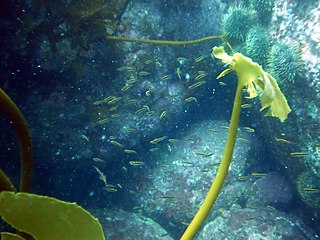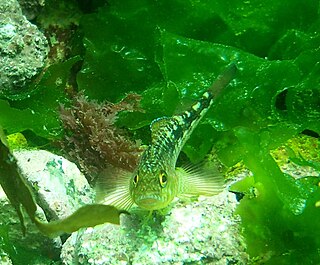
The yellow-and-black triplefin, Forsterygion flavonigrum, a triplefin of the genus Forsterygion, is found around the north of the North Island of New Zealand at depths of between 15 and 30 m, in reef areas of broken rock. Its length is between 4 and 7 cm.

The oblique-swimming triplefin, Forsterygion maryannae, is a triplefin, found along the north east coast of the North Island of New Zealand from depths of about 5 m to 50 m. They are the only triplefins not to spend most of their time resting on the bottom, instead swimming in loose schools of up to hundreds of individuals above rocky reefs. When swimming their head is higher than the tail, giving rise to their common name.

The blue dot triplefin, Notoclinops caerulepunctus, is a fish in the genus Notoclinops, found around offshore islands and exposed headlands of the eastern side of Northland, and the Bay of Plenty, on the North Island of New Zealand from depths of a metre or so to about 30 m, most common in reef areas of broken rock. Its length is only up to about 5 cm and it is the smallest of the triplefins in New Zealand.

The common triplefin, Forsterygion lapillum, is a fish of the genus Forsterygion, found around the coast of New Zealand down to depths of about 15 m. Its length is between 4 and 8 cm. It is commonly found in intertidal rock pools. It can also be found in water as deep as 30m, feeding primarily on crustaceans and polychaetes.
The scaly-headed triplefin, Karalepis stewarti, is a triplefin, the only species in the genus Karalepis. It is endemic to New Zealand where it is found around North Island, South Island, the Three Kings Islands, Snares Island and Stewart Island. It is a nocturnal species It occurs at depths of about 5 to 30 metres, in reef areas of broken rock. The specific name honours Andy Stewart of the Department of Fishes at the National Museum of New Zealand.

The variable triplefin or striped triplefin, Forsterygion varium, is a triplefin native to New Zealand, but also introduced to Tasmania, Australia, most likely in shipments of oysters. It is found in rock pools and depths down to 30 metres, in reef areas of broken rock with kelp.
The mottled triplefin, Forsterygion malcolmi, is a triplefin of the genus Forsterygion, found around New Zealand at depths down to 30 m, in reef areas of broken rock. Its specific name honours Malcolm Francis of the Fisheries Research Centre in Wellington, New Zealand, who joined Hardy on his trips to collect specimens.
The cryptic triplefin, Cryptichthys jojettae, is a triplefin of the family Tripterygiidae, the only member of the genus Cryptichthys, found around the coast of New Zealand. It length is up to 6 cm. The specific name honours a former staff member at the National Museum of New Zealand, Jorjette Drost, who participated in collecting specimens with Hardy.

Forsterygion is a genus of triplefins in the family Tripterygiidae native to coastal New Zealand, but also introduced to Tasmania, Australia.

The bullhead triplefin is a fish of the family Tripterygiidae and only member of the genus Trianectes
Apopterygion alta, known commonly as the tasselled triplefin, is a species of triplefin blenny. It is endemic to the waters off south-eastern Australia from northern Tasmania to Port Phillip in Victoria. It is normally observed on yellow sponges.
Enneapterygius flavoccipitis, the yellownape triplefin or northern bicoloured triplefin, in Australia, is a species of threefin blenny in the genus Enneapterygius.
The northern yellow-black triplefin, also known as the northern Australian yellow-black triplefin, is a species of triplefin blenny in the genus Enneapterygius. It was described by German Ichthyologist Ronald Fricke in 1994. It is a tropical blenny, endemic to northern Australia, in the western Pacific and southeastern Indian Oceans. It is a non-migratory species which dwells in shallow tidal pools on coralline rock and in seagrass, and has been recorded swimming at a depth range of 0–15 m (0–50 ft). Male northern yellow-black triplefins can reach a maximum length of 2.8 centimetres.
The halfblack triplefin, also known as the half-black triplefin, blackbelly triplefin, or the green-tail threefin, is a species of triplefin blenny in the genus Enneapterygius. It was originally described by R. Kner and F. Steindachner in 1867. It is a non-migratory tropical blenny known from coral reefs in the western Pacific Ocean, and has been described from the Ryukyu Islands to eastern Australia. It has been recorded swimming at a depth range of 0–30 metres.

Forsterygion capito, known commonly as the spotted robust triplefin, is a species of triplefin blenny in the genus Forsterygion. It was described by Jenyns in 1842. This species is endemic to New Zealand where it occurs around the North and South Islands, Stewart Island, Auckland Islands, Snares Islands, Antipodes Islands and Chatham Islands. The adults occur along sheltered coastal reefs and in harbours and bays with substrates consisting of rock and shell. They range in depth from intertidal pools to 12 metres (39 ft), or more. They prey on small benthic animals which are swallowed whole.

The estuarine triplefin or the cockabully is a species of triplefin blenny in the genus Forsterygion. It was described by Achille Valenciennes in 1836. It is found in the Southwest Pacific, throughout New Zealand.
Gilloblennius abditus, known commonly as the obscure triplefin, is a species of triplefin blenny in the genus Gilloblennius. It was described by Graham Stuart Hardy in 1896. It is endemic to New Zealand where it has a disjunct distribution around North and South Islands where there are highly exposed rocky coasts.
Matanui bathytaton, known commonly as the Chatham deep-water triplefin, is a species of triplefin blenny in the genus Matanui. It was described by Graham S. Hardy in 1989. This species occurs at depths between 12 and 550 metres on waters off New Zealand including the Chatham Rise, southeast South Island, Auckland Islands, Antipodes Islands and Stewart Island.

Trinorfolkia clarkei, known commonly as the Clarke's triplefin or Clarke's threefin, is a species of triplefin blenny in the genus Trinorfolkia. It was described by Alexander Morton in 1888 from specimens collected from Clarke Island in the Bass Strait. This species occurs I southern and western Australia from Camden Haven in New South Wales to Rottnest Island in Western Australia and around Tasmania. It occurs on coastal reefs and in estuaries frequently being observed around the pylons supporting structures such as jetties.
Trinorfolkia incisa, known commonly as the notched triplefin or notched threefin, is a species of triplefin blenny in the genus Trinorfolkia. It was described by Rudie Kuiter in 1986. This species is found at depths of between 10 and 30 metres on the roofs of caves. This species occurs along the southern coast of Australia from the south western coast of Western Australia to Victoria and around Tasmania.










